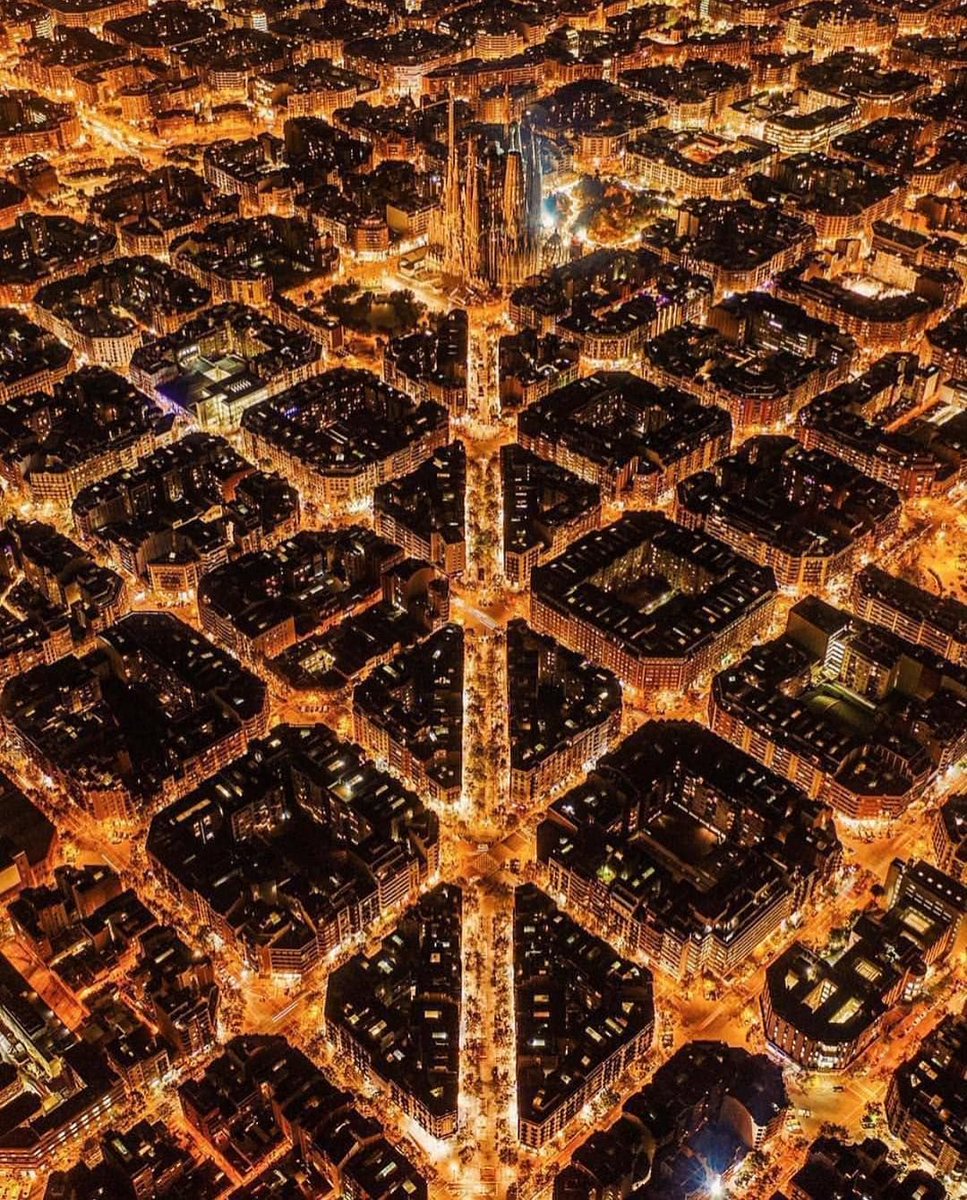The Sagrada Família in Barcelona, started 142 years ago and still not quite finished, is one of the world's most beloved buildings.
And that makes sense, because it's totally unique, right? Not exactly.
This is the story of how you create an iconic building...
And that makes sense, because it's totally unique, right? Not exactly.
This is the story of how you create an iconic building...

The Basilica di Sagrada Família, meaning the Basilica of the Holy Family, is Antoni Gaudí's masterpiece.
He took over as chief architect in 1883, one year after construction had started, and totally transformed the project.
141 years later it is still incomplete.
He took over as chief architect in 1883, one year after construction had started, and totally transformed the project.
141 years later it is still incomplete.

A lack of funds, the Civil War, and the loss of Gaudí's original plans have all delayed construction — plus the sheer time needed to build a cathedral.
You can even see how long it has taken by comparing older and newer stonework.
But they are close... only two years left.
You can even see how long it has taken by comparing older and newer stonework.
But they are close... only two years left.

Gaudí poured his heart into the project, designing every last detail of the church with scrupulous care, fearless vision, and an impressive virtuosity.
This building is defined by its flowing shapes, inspired by nature, and an endless procession of colour and light.
This building is defined by its flowing shapes, inspired by nature, and an endless procession of colour and light.

Gaudí's genius was to take recognisable, time-honoured architectural styles and breathe new life into them.
The Passion Façade is clearly inspired by Gothic Architecture, but it totally reinvents a familiar sight:
The Passion Façade is clearly inspired by Gothic Architecture, but it totally reinvents a familiar sight:

There is probably no other building in the world, on such a vast scale, which has been so minutely and carefully designed.
From the fabulous bronze doors, whether decorated like a canopy of leaves or with relief sculptures, to the colourful spires:
From the fabulous bronze doors, whether decorated like a canopy of leaves or with relief sculptures, to the colourful spires:

And the gargoyles, a famous and vital feature of Gothic architecture — only here, rather than demons, we find snails, lizards, and snakes: 

And the fabulous Nativity Façade, overflowing with detail, sculpture, and wildly original organic forms.
True to the spirit of Gothic Architecture rather than merely imitating it.
True to the spirit of Gothic Architecture rather than merely imitating it.

Unsurprisingly, then, Antoni Gaudí is the most famous Catalan architect.
His unique methods of design are beloved around the world and have helped make Barcelona into the globally iconic city it is today:
His unique methods of design are beloved around the world and have helped make Barcelona into the globally iconic city it is today:

But Gaudí and his Sagrada Família did not just appear out of nowhere.
The story began in 1855, when Barcelona was a filthy Medieval city with 200,000 people squeezed into just two square kilometres, within the old walls.
Disease and squalor were rampant; something had to give.
The story began in 1855, when Barcelona was a filthy Medieval city with 200,000 people squeezed into just two square kilometres, within the old walls.
Disease and squalor were rampant; something had to give.

A project was announced to demolish the walls and expand, called the "Eixample".
The design was by Ildefons Cerdà, who quit his job to perform topographical studies of Barcelona — right person, right time.
Everything in black is Barcelona in 1855; everything else would be new.
The design was by Ildefons Cerdà, who quit his job to perform topographical studies of Barcelona — right person, right time.
Everything in black is Barcelona in 1855; everything else would be new.

So the walls were demolished and the expansion began, slowly turning the city into a modern metropolis.
A flashpoint came when Barcelona was chosen to host the 1888 Universal Exposition.
With the eyes of the world turned on them, here was a chance to do something truly special.
A flashpoint came when Barcelona was chosen to host the 1888 Universal Exposition.
With the eyes of the world turned on them, here was a chance to do something truly special.

In preparation for the Universal Exposition the old citadel was demolished and the Parc de la Ciutadella was established in its place.
Other landmarks were also built, like Josep Vilaseca i Casanovas' fabulous red brick Arc de Triomf.
Momentum was building.
Other landmarks were also built, like Josep Vilaseca i Casanovas' fabulous red brick Arc de Triomf.
Momentum was building.

And it exploded into life with a style called "Catalan Modernism".
This was, in some sense, a subgenre of Art Nouveau, a broader movement sweeping Europe.
But in Catalunya it became its own thing entirely: the sheer colour, exuberance, and originality were unmatched.
This was, in some sense, a subgenre of Art Nouveau, a broader movement sweeping Europe.
But in Catalunya it became its own thing entirely: the sheer colour, exuberance, and originality were unmatched.

So Gaudí was only one member of a generation of architects who, as part of the Renaixença — the Catalan Renaissance — worked tirelessly to give Catalunya beautiful architecture and unique identity.
Like Hospital de la Santa Creu i Sant Pau, designed by Lluís Domènech i Montaner:
Like Hospital de la Santa Creu i Sant Pau, designed by Lluís Domènech i Montaner:

Or the extraordinary Palau de la Música Catalana, built in 1908 and also designed by Lluís Domènech i Montaner: 

This generation of architects, spurred on and aided by Cerdá's visionary urban plan (which is where those famous chamfered blocks came from) gave Barcelona that thing every city dreams of: an identity.
There's no magic — Barcelona is a product of planning, funding, and passion.
There's no magic — Barcelona is a product of planning, funding, and passion.

All of this was the background against which the Sagrada Família emerged.
The building itself may be unique in some sense, but it is not a sort of inexplicable one-off achivement.
Rather, it is the crowning jewel of a conscious process of architecture, design, and planning.
The building itself may be unique in some sense, but it is not a sort of inexplicable one-off achivement.
Rather, it is the crowning jewel of a conscious process of architecture, design, and planning.

The story of Barcelona, of Catalan Modernism, of the Sagrada Família, is important.
Because it shows that "beautiful cities" aren't just dreams, nor places we can only visit on holiday, and nor do they simply appear.
It is possible to design good cities purposively.
Because it shows that "beautiful cities" aren't just dreams, nor places we can only visit on holiday, and nor do they simply appear.
It is possible to design good cities purposively.
It's also a reminder of just how important architecture and urban design are, and what they can do for a city or region.
The unique architectural legacy bequeathed to Catalunya is part of what makes it so popular; Barcelona is Spain's most popular tourist destination.
The unique architectural legacy bequeathed to Catalunya is part of what makes it so popular; Barcelona is Spain's most popular tourist destination.

And, also, it tells us that so-called "traditional architecture" is still possible — that modern materials and methods can be united with traditional design.
That was the whole point of Art Nouveau and Catalan Modernism.
Continuing, today with the Sagrada Família:
That was the whole point of Art Nouveau and Catalan Modernism.
Continuing, today with the Sagrada Família:

As an aside it's also worth noting that not everybody liked the Sagrada Família at first.
Pablo Picasso said both it and Gaudí should be sent to hell, while George Orwell said he wished it had been destroyed during the war.
You can't please everybody.
Pablo Picasso said both it and Gaudí should be sent to hell, while George Orwell said he wished it had been destroyed during the war.
You can't please everybody.
Above all the story of Gaudí, the Sagrada Família, Catalan Modernism, and Barcelona is about imagination.
It's easy to get bogged down in details, economics, politics, "sides", and narratives.
Catalan Architecture reminds us not to forget what imagination can achieve.
It's easy to get bogged down in details, economics, politics, "sides", and narratives.
Catalan Architecture reminds us not to forget what imagination can achieve.

• • •
Missing some Tweet in this thread? You can try to
force a refresh























